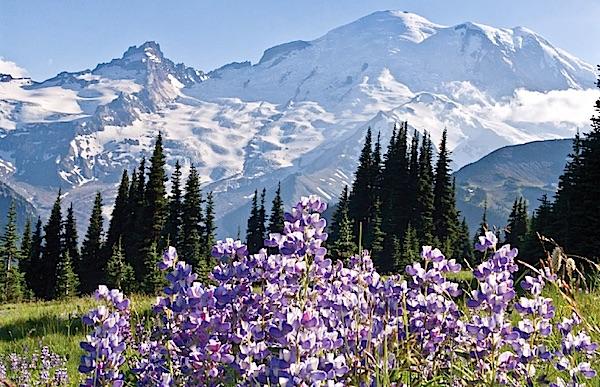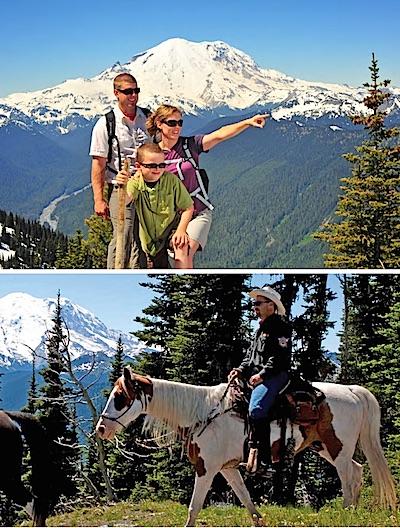
Lupines and snow combine for the perfect pastoral keepsake photo of your Mount Rainier vacation/© Tom Dempsey/PhotoSeek.com
Editor's note: This is a special advertiser-supported article from the Essential Park Guide, Summer 2015.
No dotted line lets you know when you cross from the Mount Baker/Snoqualmie National Forest into Mount Rainier National Park, or vice versa. Verdant forests of mountain hemlock, Western red cedar, and Douglas fir conceal the border between the two landscapes, a border broken only occasionally where roads and trails weave through the trees.
Open your vehicle's windows as you explore this landscape on the northeastern side of the national park and the sweet, piney aroma of the forests engulfs you. Through the windows Mount Rainier practically begs you to pull over and snap a selfie with that snow-shrouded 14,410- foot peak over your shoulder.
Following the mild winter in the Cascades, now is the time to get a jump on your summer vacation to Rainier, as both Cayuse Pass leading to the southern side of the park and Chinook Pass along the northeastern border opened historically early in April.
Entering the park via Highway 410, your destination'if this is your first trip to Mount Rainier'should be Sunrise. Located at an elevation of 6,400 feet on the mountain's eastern flanks, it's the highest point to which you can drive in the park' and all the Cascades, for that matter.
Because Sunrise stands 1,000 feet higher than Paradise on the southwestern slopes of the park, it offers the park's most panoramic views'and, as its name implies, a front-row seat for sunrise. You'll want to experience that at least once during your stay, for a beautiful pink/orange alpenglow envelops the mountain right before the sun climbs above the eastern horizon.
Though higher than Paradise, the Sunrise area melts out quickly in the summer thanks to its exposure, making it perfect for summer and fall hiking and wildflowers.
The folks at StayRainier.com are focused on the Sunrise side of Mount Rainier National Park, with lots of suggestions for things to do, but here are some of their favorites. A number of great hikes start right at Sunrise. Families love the easy hike to Shadow Lake, where frogs fresh out of hibernation provide hours of croaking entertainment for kids. The Burroughs Mountain Trail (First and Second Burroughs) offers a moderately strenuous, nearly 5-mile hike, that might provide views of mountain goats while leading you so close to the summit that you feel like you can reach out and touch it. And the 360-degree views from Dege Peak off the Sourdough Ridge Trail will keep your camera busy.

Mount Rainier's snow-cloaked flanks are always in view during your vacation / StayCrystal.com
Hook up with Crystal Mountain Outfitters and enjoy the view from the saddle / VisitRainier.com
The Sunrise Visitor Center (open June 27 through early September) is a cozy place to recoup from a hike or to seek shelter within if a rainstorm passes through the area. Hear stories and history along one of the guided walks or free ranger-led programs, and then browse geology and wildlife exhibits or gaze through a telescope at climbers headed for the summit and Emmons Glacier. You'll also find a day lodge here with a gift shop and cafeteria.
Access to the White River Campground via the Sunrise road (halfway up) opens May 1 this year and often stays open well into October. Because Sunrise is so high, the 11-mile road to the top usually doesn't open until late June, but this year the low snowfall means the park is opening the road on June 7. Not only can you hike the Glacier Basin Trail (the route taken by climbers heading for the summit from this side), but you can explore the Summerland Trail or Owyhigh Lakes Trail along the way. (Summerland is sometimes referred to as a Marmot Metropolis, particularly in the early summer when the marmots come out of their long winter's sleep.)
Anyone with plans for hiking should explore the Tipsoo Lake area. In late summer, the profusion of wildflowers rivals those at Paradise and, at sunset and sunrise, you can get the most incredible reflections of Mount Rainier in the lake. On a full moon night you're likely to come upon photographers camped out in their cars waiting for the perfect shot.
The Naches Peak Loop is another famed trail that's easy for almost everyone. Start by the pedestrian overpass and hike it counterclockwise to get views of Mount Rainier for the last half mile.
Crystal Mountain Resort provides activities you won't find anywhere else around Mount Rainier National Park. Located just off Highway 410 outside the Park's Sunrise entrance, the ski resort is home of the Mount Rainier Gondola and, in winter months, Washington's largest ski area.
The gondola in summer opens up more than 35 miles of hiking trails to you on the roof of the resort. Views that stretch from Mount Baker in the north to Mount Adams in the south complement arguably the best view of Mount Rainier itself.
U.S. Forest Service rangers at the summit can help guide you along some of the hiking trails, while Crystal Mountain Outfitters offers horseback rides on the mountain. After your explorations, the Summit House is ready to serve you gourmet lunches and dinners built around fresh, local ingredients.
In addition to the Summit House, the area has a wonderful selection of eateries. At Crystal, check out the Alpine Inn for gourmet dining and Saturday wine tastings throughout the summer.
Because the eastern side of Mount Rainier is so undeveloped, most of the lodging is concentrated in the Crystal Mountain area. Along with lodging at the Alta Crystal Resort, you'll find other options (Silver Skis Chalet, Crystal Mountain Hotels, Crystal Chalets) at Crystal Mountain.
Access, lodging, and adventures, all on the sunny side of Mount Rainier.



Comments
I was at Paradise last week, and I couldn't believe how little snow there was. Just a few plowed piles in the parking lot and a bit in the shady places, and that was about it.
The early flowers are already spectacular. It looks like early July up there.